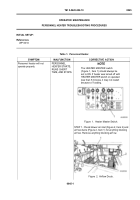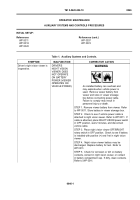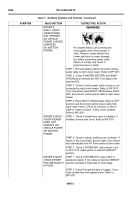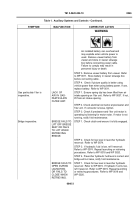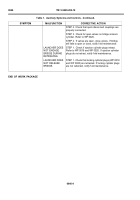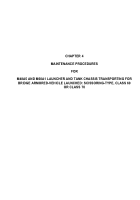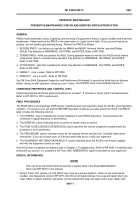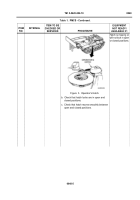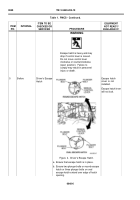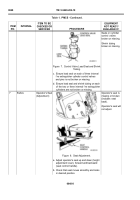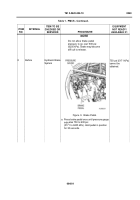TM-5-5420-202-10 - Page 268 of 535
0047
TM 5-5420-202-10
2. Rust and Corrosion. Check AVLB body and frame for rust and corrosion. If any bare metal or corrosion
exists, clean and apply a thin coat of cleaner and preservative lubricant (WP 0079, Item 42). Report it to
your supervisor.
3. Bolts, Nuts, and Screws. Check for obvious looseness and missing, bent, or broken condition. You cannot
try them all with a tool, but look for chipped paint, bare metal, or rust around bolt heads. If you
find
a bolt,
nut, or screw you think is loose, tighten it or report it to your supervisor.
4. Welds. Look for loose or chipped paint, rust, or gaps where parts are welded together. If you f
in
d a bad
weld, report it to your supervisor.
5. Electric Wires and Connectors. Look for cracked, frayed, or broken insulation; bare wires; and loose or
broken connectors. Tighten loose connectors. Report any damaged wires to your supervisor.
6. Hoses and Fluid Lines. Look for wear, damage, and leaks, and ensure clamps and f ttings are tight. Wet
spots indicate leaks, but a stain around a f tting or connector can also mean a leak. If a leak comes from a
loose f tting or connector, tighten it. If something is broken or worn out, report it to your supervisor.
When you check for operating condition, look at the component to see if it is serviceable.
When cleaning grease buildup or rust, use a cleaning solvent. Then apply a thin coat of light oil to affected area.
OIL FILTERS
Oil f lters shall be serviced/cleaned/changed, as applicable, when:
1. They are known to be contaminated or clogged.
2. Service is recommended by Army Oil Analysis Program (AOAP) laboratory analysis.
3. At prescribed hardtime intervals.
FLUID LEAKAGE
NOTE
• Equipment operation is allowed with minor leakage (Class I or II). Consideration must be
given to f uid capacity in the item/system being checked/inspected. When in doubt, notify
your supervisor.
• Class III leaks should be reported immediately to your supervisor using DA Form 2404
(Equipment Inspection and Maintenance Worksheet).
It is necessary for you to know how f uid leakage affects the status of the AVLB. Following are types/classes of
leakage you need to know to be able to determine the status of the AVLB. Learn these leakage de
finitions
and
remember - when in doubt, notify your supervisor.
When operating with Class I or II leaks, continue to check f uid levels as required in the PMCS.
1. CLASS I - Leakage of f uid (as indicated by wetness or discoloration) not great enough to form drops.
2. CLASS II - Leakage of f uid great enough to form drops but not enough to cause drops to drip from item
being checked/inspected.
3. CLASS Ill - Leakage of f uid great enough to form drops that fall from item being checked/inspected.
ENDOFWORKPACKAGE
0047-2
SPECIAL INFORMATION - CONTINUED
Back to Top


